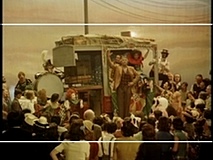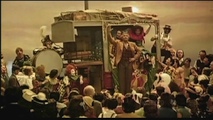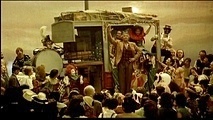Widescreen and Low Definition
Even though most TV broadcasting is in high definition, low-definition video still shows up now and then. Here's an example, taken from a recent PBS program.
On the left is a (greatly reduced) still frame from the broadcast. On the right is a detail, full size; it is quite blurry, even for standard TV. (You can click on the reduced picture to view the entire frame full size.)
I own a DVD of the filmed opera that was the source of the clip shown in the broadcast. The pictures below show the same frame from the DVD. It is in standard 4:3 format, shown with black bars, but it is much sharper (though smaller) than the broadcast clip.
 Apparently the people who put together the PBS broadcast — in widescreen format — did not wish to have black bars in any of their clips, so whenever their original material was in 4:3 aspect ratio, they enlarged it and cropped it to 16:9, as shown here.
Apparently the people who put together the PBS broadcast — in widescreen format — did not wish to have black bars in any of their clips, so whenever their original material was in 4:3 aspect ratio, they enlarged it and cropped it to 16:9, as shown here.
Unfortunately, any time you enlarge the video picture size, you not only enlarge its blurriness, you also add more blurriness in the process of scaling. The next two pictures show the results I got when I enlarged and cropped the DVD frame using computer software.
I was surprised to see that my enlarged picture, while blurrier than the original, is not as blurry as the broadcast. To show that more clearly, here are those detail pictures side by side.


I guess the people at PBS worked from an old videotape rather than the film version that was used for the DVD. Whatever the cause, I find it depressing that PBS would sacrifice image quality to avoid those black bars.
Last updated on 12/22/2011
Copyright © 2011 Allen Watson III



